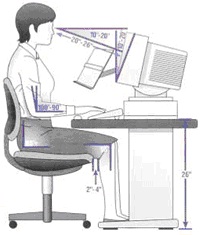
Are Writers at Risk of Suffering from Computer Vision Syndrome
 There are blind writers, who probably are the only ones not at risk to suffer from Computer Vision Syndrome (CVS). For the rest of us seeing writers, spending many hours in front of computer screen, put us at risk According to the US National Institute for Occupational Safety and Health (or NIOSH), 90% of people spending 3 hours or more per day in front of a computer will suffer from CVS at some point, so let’s see how to prevent that.
There are blind writers, who probably are the only ones not at risk to suffer from Computer Vision Syndrome (CVS). For the rest of us seeing writers, spending many hours in front of computer screen, put us at risk According to the US National Institute for Occupational Safety and Health (or NIOSH), 90% of people spending 3 hours or more per day in front of a computer will suffer from CVS at some point, so let’s see how to prevent that.
Still, better begin by
Understanding what is CVS
According to the American Optometric Association, Computer Vision Syndrome “describes a group of eye and vision-related problems that result from prolonged computer use. Many individuals experience eye discomfort and vision problems when viewing a computer screen for extended periods. The level of discomfort appears to increase with the amount of computer use.”
Symptoms commonly associated with (CVS) are
- eyestrain
- headaches
- blurred vision
- dry eyes
- neck and shoulder pain
These may be caused by:
- poor lighting
- glare on the computer screen
- improper viewing distances
- poor seating posture
- uncorrected vision problems
- a combination of these factors
- Uncorrected vision problems
So preventing or reducing vision problems associated with Computer Vision Syndrome involve controlling lighting and glare on the computer screen, establishing proper working distances and posture for computer viewing, and assuring that even minor vision problems are properly corrected.
So how do we prevent CVS occurrences
First, as for all problems related to excessive sitting in front of a computer, we sit in the right position, which benefits both the back, the blood flow, the metabolic rate and the eyes, all in one go.
Proper body positioning for computer use.
Other important factors in preventing or reducing the symptoms of CVS have to do with the computer and how it is used. This includes lighting conditions, chair comfort, location of reference materials, the position of the monitor, and the use of rest breaks.
- Location of the computer screen – Optimally, the computer screen should be 15 to 20 degrees below eye level (about 4 or 5 inches) as measured from the center of the screen and 20 to 28 inches from the eyes.
- Reference materials – These materials should be located above the keyboard and below the monitor. If this is not possible, a document holder can be used beside the monitor. The goal is to position the documents so you do not need to move your head to look from the document to the screen.
- Lighting – Position the computer screen to avoid glare, particularly from overhead lighting or windows. Use blinds or drapes on windows and replace the light bulbs in desk lamps with bulbs of lower wattage (alternatively, use antiglare screens).
- Seating position – Chairs should be comfortably padded and conform to the body. Chair height should be adjusted so your feet rest flat on the floor. If your chair has arms, they should be adjusted to provide arm support while you are typing. Your wrists shouldn’t rest on the keyboard when typing.
- Rest breaks – To prevent eyestrain, try to rest your eyes when using the computer for long periods. Rest your eyes for 15 minutes after two hours of continuous computer use. Also, for every 20 minutes of computer viewing, look into the distance for 20 seconds to allow your eyes a chance to refocus.
- Blinking – To minimize your chances of developing dry eye when using a computer, make an effort to blink frequently. Blinking keeps the front surface of your eye moist.
So in fact, as usual, the same methods work for everything. Sit right, position screen properly and have frequent breaks seem to be the mantra for all excessive computer time-related problems. Yes, in this case, we add a bit of blinking and some eye focusing exercises during the breaks, but is all remains very easy to establish, so, nothing will stop us from writing. Readers can relax, their favorite writers won’t be disabled any time soon 🙂
Back to the Main article
